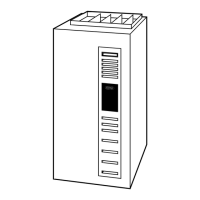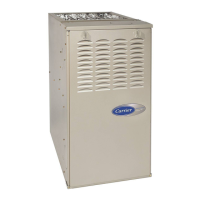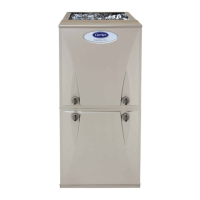440 01 4801 00 37
Specifications subject to change without notice.
CARBON MONOXIDE POISONING HAZARD
Failure to follow the instructions outlined below for each
appliance being placed into operation could result in carbon
monoxide poisoning or death.
The instructions included with this furnace DO NOT APPLY
to vent systems that are located below the furnace.
CAREFULLY FOLLOW THE INSTRUCTIONS
PROVIDED WITH THE EXTERNAL VENT TRAP KIT
FOR LAYING OUT THE VENTING SYSTEM AND
THE DRAIN SYSTEM when all or part of the venting
system is placed below the furnace.
Proper configuration of the venting and drain system is critical
when placing all or part of the venting system below the level
of the furnace. VENT GASSES COULD BE RELEASED
FROM THE DRAINAGE SYSTEM if the instructions
provided with the External Vent Trap Kit are not followed.
!
WARNING
Non-Direct Vent (1-pipe) System
In a non direct-vent (1-pipe) system, all air for combustion is taken
from the area adjacent to furnace, and all flue products are
discharged to outdoor atmosphere. Air for combustion must be
supplied as described in the Air For Combustion and Ventilation
Section. Do not use an abandoned chimney to supply outside air to
the furnace. See Fig. 43 for references to vent clearances required
by National code authorities.
A combustion air pipe to the outdoors is not required for a
single--pipe vent system. A 12-in. (304 mm) long pipe with a 2-- in.
(51 mm) tight radius 90 degree elbow is required to be attached to
the combustion air pipe adapter on the furnace. See Fig. 49. This
short inlet air pipe helps to ensure stable combustion, as well as
allow for sound attenuation. To aid sound attenuation, point the
inlet air pipe away from occupants. An extra elbow and/or five
feet of pipe may be used to accomplish the sound attenuation
function.
OPTIONAL VENTING BELOW THE FURNACE
The venting system may be positioned below the furnace
ONLY IF the factory accessory External Vent Trap Kit is used.
The External Vent Trap Kit is only approved for PVC/ABS
DWV venting systems.
CAREFULLY FOLLOW THE INSTRUCTIONS
PROVIDED WITH THE EXTERNAL VENT TRAP KIT
FOR LAYING OUT THE VENTING SYSTEM AND
THE DRAIN SYSTEM. The instructions included with this
furnace DO NOT APPLY to vent systems that are located
below the furnace.
NOTICE
Locating the Vent Termination
General
NOTE: Termination Requirements for the Provinces of
Alberta and Saskatchewan are located at the end of this
section.
Combustion--air inlet pipe (direct vent/2--pipe system only) and
vent pipe must terminate outside structure, either through sidewall
or roof.
For vent termination clearance, references to National codes are
shown in Fig. 42 for Direct Vent/2-- Pipe system and Fig. 43 for
Ventilated Combustion Air/Non--direct Vent/1--Pipe system. For
exterior termination arrangements, refer to Fig. 40 for Direct
Vent/2--Pipe system and Fig. 41 for Ventilated Combustion
Air/Non--Direct/1--Pipe system. Contact Local code authorities for
other requirements to and/or exemptions from the National codes
shown in the figures.
Roof termination is the recommended termination location. Roof
terminations provide better performance against sustained
prevailing winds. The roof location is preferred since the vent and
combustion air system is less susceptible to damage or
contamination. The termination is usually located away from
adjacent structures or other obstacles such as inside corners,
windows, doors or other appliances. It is less prone to icing
conditions, and it often has less visible vent vapors.
Sidewall terminations may require sealing or shielding of building
surfaces with a corrosive resistance material due to the corrosive
properties of combustion products from the vent system, as well as
protection of adjacent structures.
When determining appropriate location for termination, consider
the following guidelines:
1. Comply with all clearance requirements stated in Fig. 42 or
Fig. 43 per application.
2. Termination or termination kit should be positioned where
vent vapors will not damage plants/shrubs, air conditioning
equipment or utility meters.
3. Do not locate termination directly into prevailing winds.
Termination should be positioned so that it will not be
affected by sustained prevailing winds over 30 mph, wind
eddy, such as inside building corners, or by recirculation of
flue gases, airborne leaves, or light snow.
4. Termination or termination kit should be positioned where it
will not be damaged by or subjected to foreign objects such
as stones, balls, etc.
5. Termination or termination kit should be positioned where
vent vapors are not objectionable.
Direct Vent / 2-Pipe System
Direct vent (2-- pipe) vent and combustion air pipes must terminate
outside the structure. See Fig. 42 for references to vent clearances
required by National code authorities. Allowable vent and
combustion air terminations are shown in Fig. 40.
Ventilated Combustion Air
The vent pipe for a Ventilated Combustion Air System must
terminate outdoors. See Fig. 43 for references to vent clearances
required by National code authorities. Allowable vent terminations
are shown in Fig. 41. The combustion air pipe terminates in a
well--ventilated attic or crawl space. Follow the clearances as
shown in Fig. 50.
The combustion air pipe cannot terminate in attics or crawl spaces
that use ventilation fans designed to operate in the heating season.
If ventilation fans are present in these areas, the combustion air
pipe must terminate outdoors as a Direct Vent System.
Non-Direct Vent / 1-Pipe System
The vent pipe for a Non Direct Vent (1-- pipe) system must
terminate outdoors. See Fig. 43 for references to vent clearances
required by National Code authorities. Allowable vent
terminations are shown in Fig. 41.
A combustion air inlet pipe to the outdoors is not required for a
Non-- Direct (single--pipe) Vent System. A 12-- in. long section of
pipe with a tight radius 2 -- in. (51 mm) 90 degree elbow is required
to be attached to the furnace. See Fig. 49. This short inlet air pipe
helps to ensure stable combustion, as well as allow for sound
attenuation. To aid sound attenuation, point the inlet air pipe away
from occupants. An extra elbow and/or five feet of pipe may be
used to accomplish the sound attenuation function.

